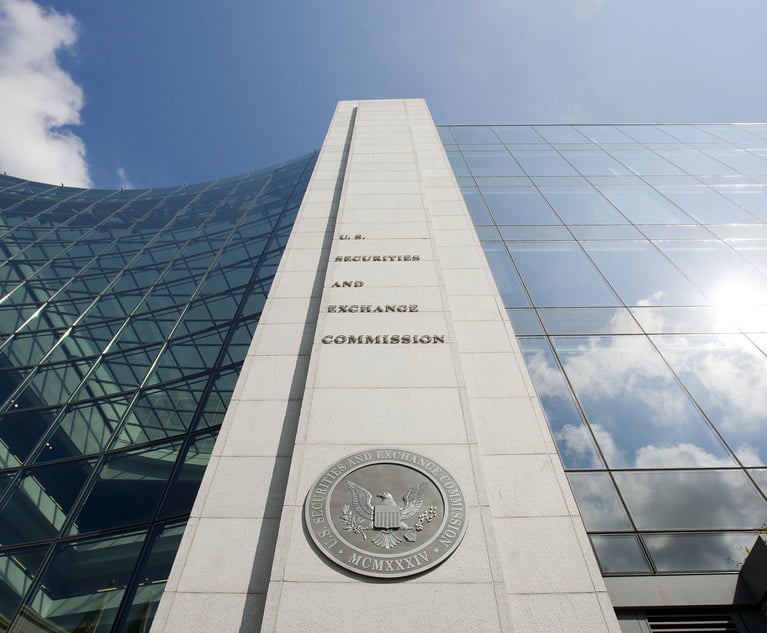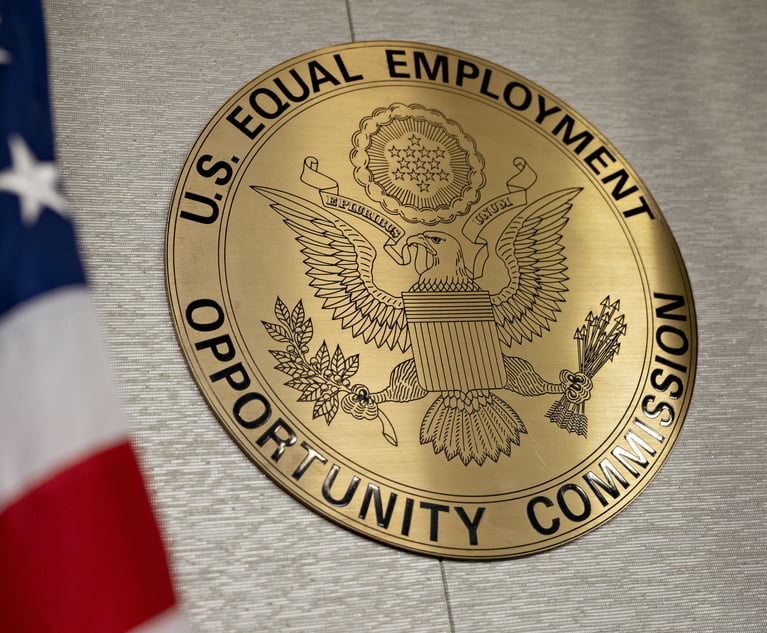Tender Revival
SEC's amendments to best price rule rekindle interest in tender offers.
January 31, 2007 at 07:00 PM
18 minute read
Judges, it seems, have a way of turning the common to the convoluted, the intuitive to the indistinct, and the obvious to the obscure. So it has been with the SEC's tender offer best price rule, which is supposed to ensure all shareholders responding to a tender offer receive the same price for their shares.
By all appearances, the best price rule represents an axiomatic or at least a quasi-axiomatic proposition. But since a 1995 federal court decision that required judges to examine virtually any collateral benefits paid by acquirers to shareholders, plaintiffs' attorneys have been holding tender offers hostage, claiming that such things as employment compensation and benefits, severance arrangements and commercial contracts between acquirers and customers or suppliers who are also shareholders offend the best price rule.
“The SEC never intended the rule to work that way, but some courts found ambiguity in the wording and gave it the interpretation it now bears,” says Joris Hogan, a partner at Torys' New York office.
Because the penalty for non-compliance is that acquirers must pay the additional benefit (on a per-share basis) to all other shareholders of a target corporation, the stakes in tender offer litigation can be enormous. It's no surprise, then, that acquirers frequently forego the advantages of tender offers and structure transactions as mergers, which do not implicate the best price rule.
Following years of lobbying by various business organizations as well as the ABA, the SEC finally decided to make changes. And with the Dec. 8 enactment of amendments to the best price rule, the tender offer may be poised for a comeback.
“The amendments will go a long way to preventing best price lawsuits, which have been the great deterrent to structuring deals as tender offers,” says James Moloney, a partner at Gibson, Dunn & Crutcher's Irvine, Calif., office.
Judicial Misinterpretation
Adding to the deterrent was the inconsistency of courts in construing the best price rule and in deciding when collateral payments fell within its ambit. Some courts have interpreted the rule narrowly. But others have found violations when shareholders of the target sign beneficial agreements or receive additional compensation shortly before the bidder makes the tender offer or soon after the transaction closes.
Because allegations based on the best price rule are essentially factual in nature–requiring a determination of the circumstances that led to the additional benefit–most of these claims went to juries. But the delays inherent in going to trial and the risk of huge jury awards were anathema to the conclusion of a transaction.
“Settlement became the only practical alternative for a bidder who wanted the deal to close, so it didn't take too many of these 'hold up' suits to convince the M&A community that the advantages of the tender offer were outweighed by the litigation and settlement costs,” says Charles Nathan, a partner at Latham & Watkins.
Under the SEC amendments, however, only consideration paid “for securities tendered” in the tender offer is subject to the best price rule.
“The addition of these words clarifies that payments made to shareholders in the course of a tender offer that are not consideration for the tendered securities do not attract the best price rule,” Hogan says.
The SEC has also adopted a more specific exemption for employment arrangements where the employee, such as a director or officer, is also a shareholder and would benefit from the employment arrangement if the tender succeeds. Examples include employees whose severance kicks in on a change of control. The exemption applies as long as the payments are compensation for past or future services and are not based on the number of securities tendered.
There also is a non-exclusive safe harbor for such arrangements where an independent board committee of the acquirer or the target approves the arrangements. Where such approval is given, dissident shareholders would be precluded from claiming the exemption did not apply.
Lingering Problems
Still, the amendments are not a cure-all. “There are nagging technical questions that may or may not slow down tender offers,” Nathan says. “When it comes to litigation and predicting what the courts will do, you should never put your children's lives on the line.”
The safe harbor, for example, does not apply to commercial arrangements.
“This means that any time you have a special commercial relationship upon which the tender offer impacts, someone could make a case that it runs afoul of the best price rule,” Hogan says.
For example, Nathan posits the case of a shareholder who is also a landlord of the target.
“If you had selling shareholders who owned warehouses that were leased to the target and the deal included an agreement that the leases would be renewed, the risk of best price litigation might still be significant,” Nathan says.
Lock-up agreements, by which major shareholders agree in advance to tender to the offer and which are critical to the success of many tender offers, also could be vulnerable.
“If lock-up agreements provide a special benefit for large shareholders, they could run afoul of the amended rules because the amendments don't remove the prohibition against shareholder benefits that are contingent on the tender of securities,” Hogan says.
But because compensation arrangements are by far the most common subject of best price litigation, the safe harbor amendments will make plaintiffs' lives far
more difficult.
“Most people in the M&A bar think that best price litigation concerns are largely a thing of the past now, meaning that we'll see a resurgence of tender offers,” Nathan says.
But that resurgence won't happen immediately.
Slow Revival
“It won't be like the curtain rises and there will suddenly be 30 tender offers in the market,” Nathan says.
“It will take time for people to process the rule change,” he says. “It will also take time for deals to come along that are a good fit for the tender offer structure, and it will take time for people to get comfortable with the rule's loose edges.”
Indeed, Nathan believes the plaintiffs' bar will take a run at the amendments.
“They don't give up easily, so it might take a test case or two before people start to feel comfortable with tender offers,” he says. “But eventually, the amendments will do what they're supposed to do because their legislative history and intent is far more clear than the murky history of the original rule.”
Judges, it seems, have a way of turning the common to the convoluted, the intuitive to the indistinct, and the obvious to the obscure. So it has been with the SEC's tender offer best price rule, which is supposed to ensure all shareholders responding to a tender offer receive the same price for their shares.
By all appearances, the best price rule represents an axiomatic or at least a quasi-axiomatic proposition. But since a 1995 federal court decision that required judges to examine virtually any collateral benefits paid by acquirers to shareholders, plaintiffs' attorneys have been holding tender offers hostage, claiming that such things as employment compensation and benefits, severance arrangements and commercial contracts between acquirers and customers or suppliers who are also shareholders offend the best price rule.
“The SEC never intended the rule to work that way, but some courts found ambiguity in the wording and gave it the interpretation it now bears,” says Joris Hogan, a partner at
Because the penalty for non-compliance is that acquirers must pay the additional benefit (on a per-share basis) to all other shareholders of a
Following years of lobbying by various business organizations as well as the ABA, the SEC finally decided to make changes. And with the Dec. 8 enactment of amendments to the best price rule, the tender offer may be poised for a comeback.
“The amendments will go a long way to preventing best price lawsuits, which have been the great deterrent to structuring deals as tender offers,” says James Moloney, a partner at
Judicial Misinterpretation
Adding to the deterrent was the inconsistency of courts in construing the best price rule and in deciding when collateral payments fell within its ambit. Some courts have interpreted the rule narrowly. But others have found violations when shareholders of the target sign beneficial agreements or receive additional compensation shortly before the bidder makes the tender offer or soon after the transaction closes.
Because allegations based on the best price rule are essentially factual in nature–requiring a determination of the circumstances that led to the additional benefit–most of these claims went to juries. But the delays inherent in going to trial and the risk of huge jury awards were anathema to the conclusion of a transaction.
“Settlement became the only practical alternative for a bidder who wanted the deal to close, so it didn't take too many of these 'hold up' suits to convince the M&A community that the advantages of the tender offer were outweighed by the litigation and settlement costs,” says Charles Nathan, a partner at
Under the SEC amendments, however, only consideration paid “for securities tendered” in the tender offer is subject to the best price rule.
“The addition of these words clarifies that payments made to shareholders in the course of a tender offer that are not consideration for the tendered securities do not attract the best price rule,” Hogan says.
The SEC has also adopted a more specific exemption for employment arrangements where the employee, such as a director or officer, is also a shareholder and would benefit from the employment arrangement if the tender succeeds. Examples include employees whose severance kicks in on a change of control. The exemption applies as long as the payments are compensation for past or future services and are not based on the number of securities tendered.
There also is a non-exclusive safe harbor for such arrangements where an independent board committee of the acquirer or the target approves the arrangements. Where such approval is given, dissident shareholders would be precluded from claiming the exemption did not apply.
Lingering Problems
Still, the amendments are not a cure-all. “There are nagging technical questions that may or may not slow down tender offers,” Nathan says. “When it comes to litigation and predicting what the courts will do, you should never put your children's lives on the line.”
The safe harbor, for example, does not apply to commercial arrangements.
“This means that any time you have a special commercial relationship upon which the tender offer impacts, someone could make a case that it runs afoul of the best price rule,” Hogan says.
For example, Nathan posits the case of a shareholder who is also a landlord of the target.
“If you had selling shareholders who owned warehouses that were leased to the target and the deal included an agreement that the leases would be renewed, the risk of best price litigation might still be significant,” Nathan says.
Lock-up agreements, by which major shareholders agree in advance to tender to the offer and which are critical to the success of many tender offers, also could be vulnerable.
“If lock-up agreements provide a special benefit for large shareholders, they could run afoul of the amended rules because the amendments don't remove the prohibition against shareholder benefits that are contingent on the tender of securities,” Hogan says.
But because compensation arrangements are by far the most common subject of best price litigation, the safe harbor amendments will make plaintiffs' lives far
more difficult.
“Most people in the M&A bar think that best price litigation concerns are largely a thing of the past now, meaning that we'll see a resurgence of tender offers,” Nathan says.
But that resurgence won't happen immediately.
Slow Revival
“It won't be like the curtain rises and there will suddenly be 30 tender offers in the market,” Nathan says.
“It will take time for people to process the rule change,” he says. “It will also take time for deals to come along that are a good fit for the tender offer structure, and it will take time for people to get comfortable with the rule's loose edges.”
Indeed, Nathan believes the plaintiffs' bar will take a run at the amendments.
“They don't give up easily, so it might take a test case or two before people start to feel comfortable with tender offers,” he says. “But eventually, the amendments will do what they're supposed to do because their legislative history and intent is far more clear than the murky history of the original rule.”
This content has been archived. It is available through our partners, LexisNexis® and Bloomberg Law.
To view this content, please continue to their sites.
Not a Lexis Subscriber?
Subscribe Now
Not a Bloomberg Law Subscriber?
Subscribe Now
NOT FOR REPRINT
© 2025 ALM Global, LLC, All Rights Reserved. Request academic re-use from www.copyright.com. All other uses, submit a request to [email protected]. For more information visit Asset & Logo Licensing.
You Might Like
View All

‘Extremely Disturbing’: AI Firms Face Class Action by ‘Taskers’ Exposed to Traumatic Content
5 minute read
In-House Lawyers Are Focused on Employment and Cybersecurity Disputes, But Looking Out for Conflict Over AI
Trending Stories
- 1Decision of the Day: Judge Dismisses Defamation Suit by New York Philharmonic Oboist Accused of Sexual Misconduct
- 2California Court Denies Apple's Motion to Strike Allegations in Gender Bias Class Action
- 3US DOJ Threatens to Prosecute Local Officials Who Don't Aid Immigration Enforcement
- 4Kirkland Is Entering a New Market. Will Its Rates Get a Warm Welcome?
- 5African Law Firm Investigated Over ‘AI-Generated’ Case References
Who Got The Work
J. Brugh Lower of Gibbons has entered an appearance for industrial equipment supplier Devco Corporation in a pending trademark infringement lawsuit. The suit, accusing the defendant of selling knock-off Graco products, was filed Dec. 18 in New Jersey District Court by Rivkin Radler on behalf of Graco Inc. and Graco Minnesota. The case, assigned to U.S. District Judge Zahid N. Quraishi, is 3:24-cv-11294, Graco Inc. et al v. Devco Corporation.
Who Got The Work
Rebecca Maller-Stein and Kent A. Yalowitz of Arnold & Porter Kaye Scholer have entered their appearances for Hanaco Venture Capital and its executives, Lior Prosor and David Frankel, in a pending securities lawsuit. The action, filed on Dec. 24 in New York Southern District Court by Zell, Aron & Co. on behalf of Goldeneye Advisors, accuses the defendants of negligently and fraudulently managing the plaintiff's $1 million investment. The case, assigned to U.S. District Judge Vernon S. Broderick, is 1:24-cv-09918, Goldeneye Advisors, LLC v. Hanaco Venture Capital, Ltd. et al.
Who Got The Work
Attorneys from A&O Shearman has stepped in as defense counsel for Toronto-Dominion Bank and other defendants in a pending securities class action. The suit, filed Dec. 11 in New York Southern District Court by Bleichmar Fonti & Auld, accuses the defendants of concealing the bank's 'pervasive' deficiencies in regards to its compliance with the Bank Secrecy Act and the quality of its anti-money laundering controls. The case, assigned to U.S. District Judge Arun Subramanian, is 1:24-cv-09445, Gonzalez v. The Toronto-Dominion Bank et al.
Who Got The Work
Crown Castle International, a Pennsylvania company providing shared communications infrastructure, has turned to Luke D. Wolf of Gordon Rees Scully Mansukhani to fend off a pending breach-of-contract lawsuit. The court action, filed Nov. 25 in Michigan Eastern District Court by Hooper Hathaway PC on behalf of The Town Residences LLC, accuses Crown Castle of failing to transfer approximately $30,000 in utility payments from T-Mobile in breach of a roof-top lease and assignment agreement. The case, assigned to U.S. District Judge Susan K. Declercq, is 2:24-cv-13131, The Town Residences LLC v. T-Mobile US, Inc. et al.
Who Got The Work
Wilfred P. Coronato and Daniel M. Schwartz of McCarter & English have stepped in as defense counsel to Electrolux Home Products Inc. in a pending product liability lawsuit. The court action, filed Nov. 26 in New York Eastern District Court by Poulos Lopiccolo PC and Nagel Rice LLP on behalf of David Stern, alleges that the defendant's refrigerators’ drawers and shelving repeatedly break and fall apart within months after purchase. The case, assigned to U.S. District Judge Joan M. Azrack, is 2:24-cv-08204, Stern v. Electrolux Home Products, Inc.
Featured Firms
Law Offices of Gary Martin Hays & Associates, P.C.
(470) 294-1674
Law Offices of Mark E. Salomone
(857) 444-6468
Smith & Hassler
(713) 739-1250







